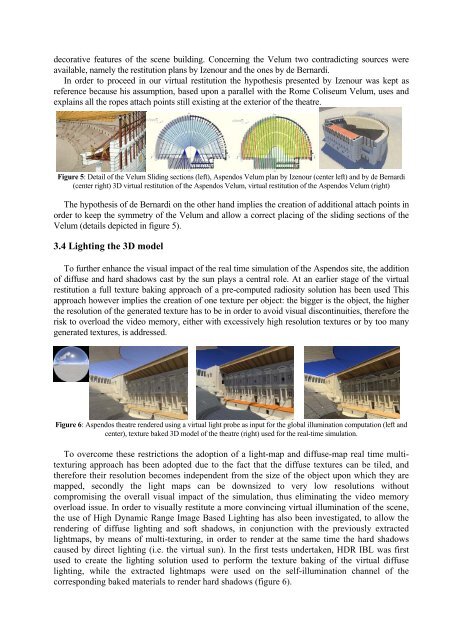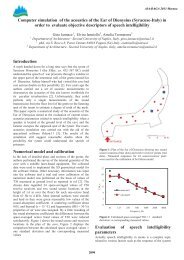ERATO Proceedings Istanbul 2006.pdf - Odeon
ERATO Proceedings Istanbul 2006.pdf - Odeon
ERATO Proceedings Istanbul 2006.pdf - Odeon
Create successful ePaper yourself
Turn your PDF publications into a flip-book with our unique Google optimized e-Paper software.
decorative features of the scene building. Concerning the Velum two contradicting sources were<br />
available, namely the restitution plans by Izenour and the ones by de Bernardi.<br />
In order to proceed in our virtual restitution the hypothesis presented by Izenour was kept as<br />
reference because his assumption, based upon a parallel with the Rome Coliseum Velum, uses and<br />
explains all the ropes attach points still existing at the exterior of the theatre.<br />
Figure 5: Detail of the Velum Sliding sections (left), Aspendos Velum plan by Izenour (center left) and by de Bernardi<br />
(center right) 3D virtual restitution of the Aspendos Velum, virtual restitution of the Aspendos Velum (right)<br />
The hypothesis of de Bernardi on the other hand implies the creation of additional attach points in<br />
order to keep the symmetry of the Velum and allow a correct placing of the sliding sections of the<br />
Velum (details depicted in figure 5).<br />
3.4 Lighting the 3D model<br />
To further enhance the visual impact of the real time simulation of the Aspendos site, the addition<br />
of diffuse and hard shadows cast by the sun plays a central role. At an earlier stage of the virtual<br />
restitution a full texture baking approach of a pre-computed radiosity solution has been used This<br />
approach however implies the creation of one texture per object: the bigger is the object, the higher<br />
the resolution of the generated texture has to be in order to avoid visual discontinuities, therefore the<br />
risk to overload the video memory, either with excessively high resolution textures or by too many<br />
generated textures, is addressed.<br />
Figure 6: Aspendos theatre rendered using a virtual light probe as input for the global illumination computation (left and<br />
center), texture baked 3D model of the theatre (right) used for the real-time simulation.<br />
To overcome these restrictions the adoption of a light-map and diffuse-map real time multitexturing<br />
approach has been adopted due to the fact that the diffuse textures can be tiled, and<br />
therefore their resolution becomes independent from the size of the object upon which they are<br />
mapped, secondly the light maps can be downsized to very low resolutions without<br />
compromising the overall visual impact of the simulation, thus eliminating the video memory<br />
overload issue. In order to visually restitute a more convincing virtual illumination of the scene,<br />
the use of High Dynamic Range Image Based Lighting has also been investigated, to allow the<br />
rendering of diffuse lighting and soft shadows, in conjunction with the previously extracted<br />
lightmaps, by means of multi-texturing, in order to render at the same time the hard shadows<br />
caused by direct lighting (i.e. the virtual sun). In the first tests undertaken, HDR IBL was first<br />
used to create the lighting solution used to perform the texture baking of the virtual diffuse<br />
lighting, while the extracted lightmaps were used on the self-illumination channel of the<br />
corresponding baked materials to render hard shadows (figure 6).
















